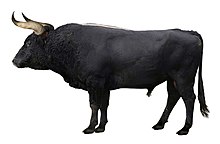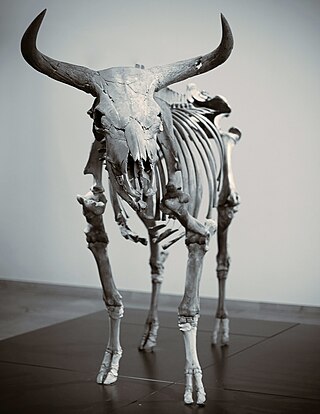
The aurochs is an extinct cattle species, considered to be the wild ancestor of modern domestic cattle. With a shoulder height of up to 180 cm (71 in) in bulls and 155 cm (61 in) in cows, it was one of the largest herbivores in the Holocene; it had massive elongated and broad horns that reached 80 cm (31 in) in length.

The zebu, sometimes known in the plural as indicine cattle or humped cattle, is a species or subspecies of domestic cattle originating in the Indian sub-continent. Zebu are characterised by a fatty hump on their shoulders, a large dewlap, and sometimes drooping ears. They are well adapted to withstanding high temperatures, and are farmed throughout the tropical countries, both as pure zebu and as hybrids with taurine cattle, the other main type of domestic cattle. Zebu are used as draught and riding animals, dairy cattle, and beef cattle, as well as for byproducts such as hides and dung for fuel and manure. Some small breeds such as the miniature zebu are also kept as pets. In 1999, researchers at Texas A&M University successfully cloned a zebu.

Bovines comprise a diverse group of 10 genera of medium to large-sized ungulates, including cattle, bison, African buffalo, water buffalos, and the four-horned and spiral-horned antelopes. The evolutionary relationship between the members of the group is still debated, and their classification into loose tribes rather than formal subgroups reflects this uncertainty. General characteristics include cloven hooves and usually at least one of the sexes of a species having true horns. The largest extant bovine is the gaur.

Bos is the genus of wild and domestic cattle. Bos is often divided into four subgenera: Bos, Bibos, Novibos, and Poephagus, but including these last three divisions within the genus Bos without including Bison in the genus is believed to be polyphyletic by many workers on the classification of the genus since the 1980s. The genus as traditionally defined has five extant species but this rises to eight when the domesticated varieties are counted as separate species, and 10 when the closely related genus Bison is also included. Most but not all modern breeds of domesticated cattle are believed to have originated from the extinct aurochs. Many ancient breeds are thought to have originated from other species. Zebus and taurine cattle are thought to descend from ancient Indian and Middle Eastern aurochs, respectively.

Breeding back is a form of artificial selection by the deliberate selective breeding of domestic animals, in an attempt to achieve an animal breed with a phenotype that resembles a wild type ancestor, usually one that has gone extinct. Breeding back is not to be confused with dedomestication.

The Heck or Munich-Berlin is a German breed or type of domestic cattle. It was bred in the 1920s by Heinz and Lutz Heck in an attempt to breed back the extinct aurochs. Controversy revolves around methodology and success of the programme. There are considerable differences between Heck cattle and the aurochs in build, height, and body proportions. Furthermore, there are other cattle breeds which resemble their wild ancestors at least as much as Heck cattle.

Chillingham cattle, also known as Chillingham wild cattle, are a breed of cattle that live in a large enclosed park at Chillingham Castle, Northumberland, England. In summer 2022 the cattle numbers 138 animals with approximately equal numbers of males and females The herd has remained remarkably genetically isolated for hundreds of years, surviving despite inbreeding depression due to the small population. There is also a small reserve herd of about 20 animals located on Crown Estate land near Fochabers, North East Scotland.
Bos acutifrons is the most ancient representative of the genus Bos, cattle. Fossils of an individual of B. acutifrons were found in middle Pleistocene-aged strata of Siwalik Hills of Kashmir, in either modern Pakistan or India, in the 19th century. The prehistoric species was described, along with B. planifrons, by Richard Lydekker in 1878. In 1898 Lydekker synonymised B. planifrons with B. acutifrons, reconsidering the skull found to be that of a female individual of the same species.
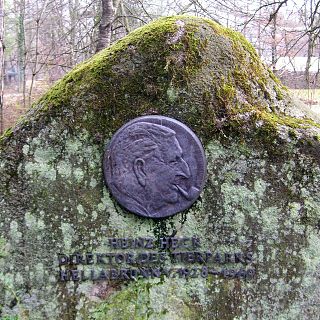
Heinz Heck was a German biologist and director of Hellabrunn Zoo in Munich. He was born in Berlin and died in Munich.

Carsington is a village in the middle of the Derbyshire Dales, England; it adjoins the hamlet of Hopton, and is close to the historic town of Wirksworth and village of Brassington.

Sanga cattle is the collective name for indigenous cattle of sub-Saharan Africa. They are sometimes identified as a subspecies with the scientific name Bos taurus africanus. Their history of domestication and their origins in relation to taurine cattle, zebu cattle, and native African varieties of the ancestral aurochs are a matter of debate.

The Indian aurochs is an extinct aurochs subspecies that is considered the wild ancestor of the domestic zebu cattle, which is mainly found in the Indian subcontinent and has been introduced in many other parts of the world, like Africa and South America. In contrast, the domesticated taurine cattle breeds, which are native to Europe, the Near East, and other parts of the world, are descendants of the Eurasian aurochs. According to IUCN, the Indian aurochs disappeared before the 13th century AD, leaving only the Bos primigenius primigenius, whose range was by then restricted to Europe. The wild population of Indian aurochs was likely extinct millennia earlier than that; the most recent skeletal remains, from Uttar Pradesh, date from around 1,800 BC.
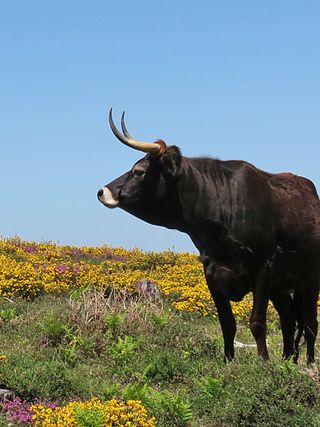
The Maronesa is a traditional Portuguese breed of mountain cattle. Its name derives from that of the Serra do Marão, which lies in the Trás-os-Montes and Douro Litoral regions in the northern part of the country. Its primary use is for draught power.
Pajuna is a rare Spanish cattle breed, originating in Granada (Andalusia), which resembles the extinct aurochs, the wild ancestor of domestic cattle, in certain features.
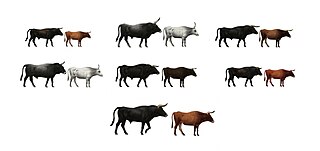
The Tauros Programme, formerly known as TaurOs Project, is a cooperation between the Dutch foundation Stichting Taurus and universities such as the Wageningen University and Research Centre. It is an international effort to breed a type of cattle that resembles the extinct aurochs, the wild ancestor of domestic cattle.
Stichting Taurus is a Dutch foundation which uses large herbivores grazing under natural circumstances for nature conservation. Robust cattle and horse breeds are used for this purpose.
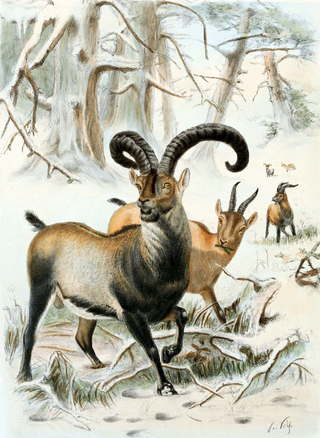
De-extinction is the process of generating an organism that either resembles or is an extinct species. There are several ways to carry out the process of de-extinction. Cloning is the most widely proposed method, although genome editing and selective breeding have also been considered. Similar techniques have been applied to certain endangered species, in hopes to boost their genetic diversity. The only method of the three that would provide an animal with the same genetic identity is cloning. There are benefits and drawbacks to the process of de-extinction ranging from technological advancements to ethical issues.

The Taurus Project of the German Arbeitsgemeinschaft Biologischer Umweltschutz aims to re-create the extinct aurochs, the wild ancestor of domestic cattle, by cross-breeding Heck cattle with aurochs-like cattle, mostly from Southern Europe. Herds of these cross-bred Taurus cattle have been established in Germany, Denmark, Hungary and Latvia, and are used in conservation of natural landscapes and biodiversity.

Hariana or haryanvi is an Indian breed of cow native to North India, specially in the state of Haryana. They produce about 10 to 15 litres of milk a day, compared to 8.9 litres when cross-bred with Holstein Friesian cattle (HS), whereas pure HS can produce 50 litres a day, but it is not as disease-resistant in the conditions of North India.

Milovice Nature Reserve is a nature reserve next to the towns of Milovice and Benátky nad Jizerou in Nymburk District, Central Bohemian Region, Czech Republic. Established in 2015, the area is administered by the Česká krajina o.p.s. organization, as a part of Evropsky významná lokalita Milovice-Mladá CZ0214006 protected area, part of the European Union project Natura 2000. This reserve is a pioneering project of cooperation between several scientific bodies and draws support from many organizations and private sponsors.
